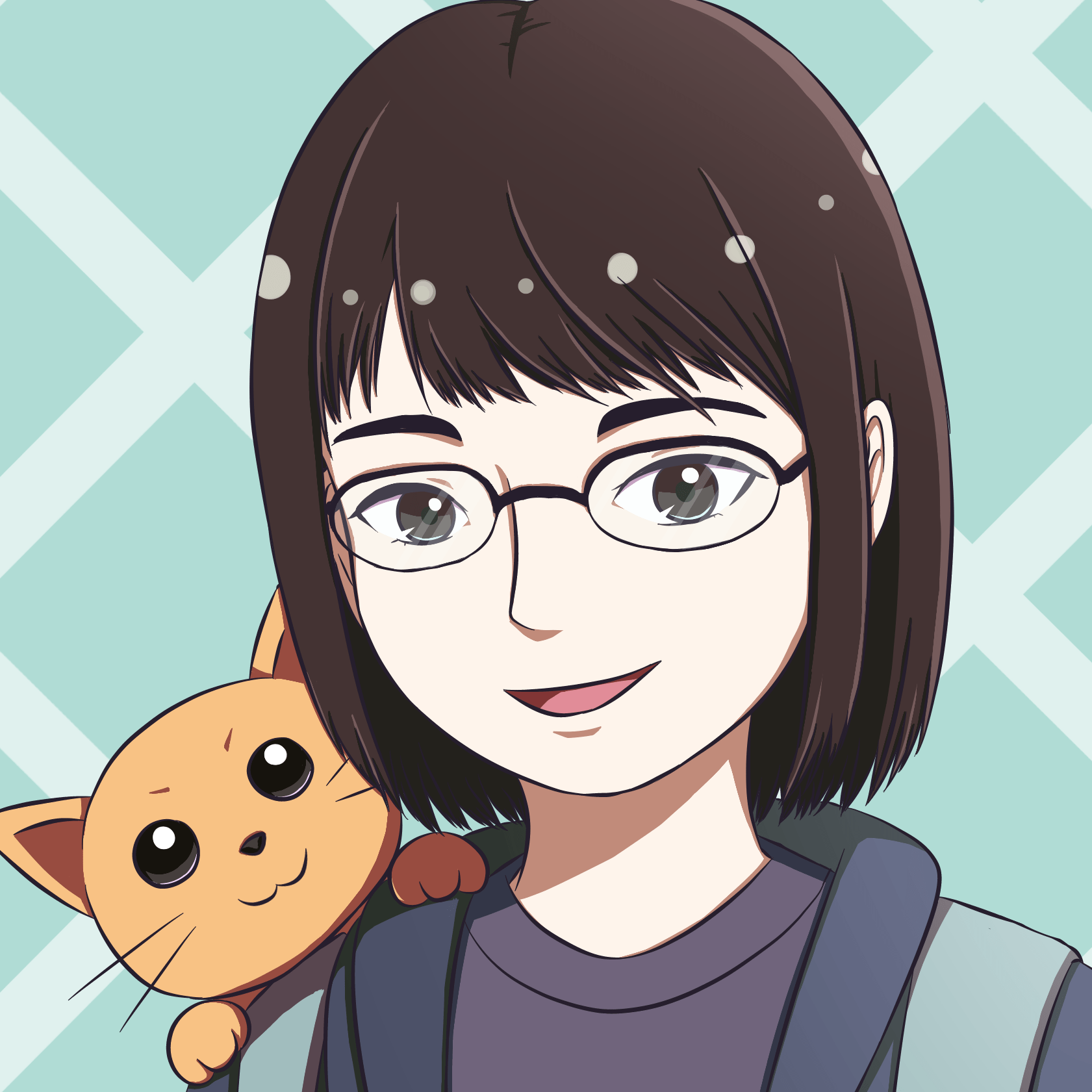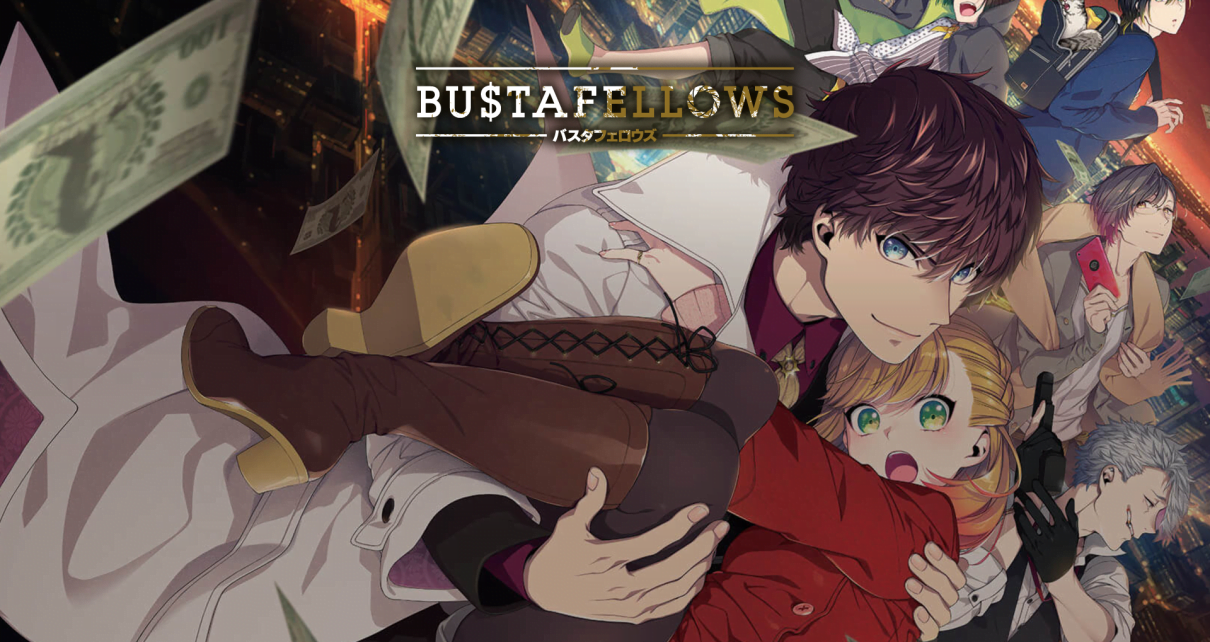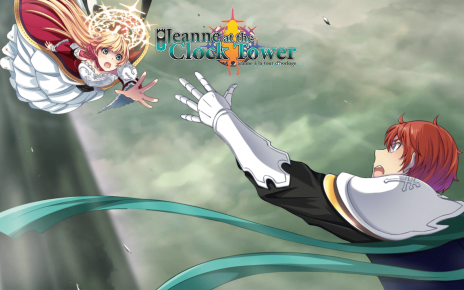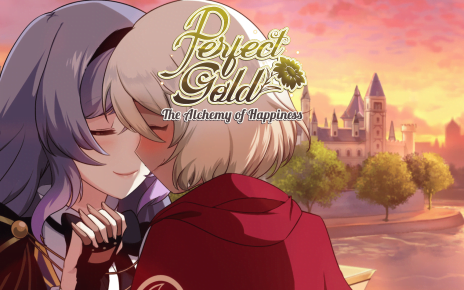I have to mention as an otome player, I am rather out of the loop. I did not know about BUSTAFELLOWS until sometime this year, even though the visual novel was first released in Japan back in December 2019 and an English localization had been announced in December 2020. Still, like many others, I have since been looking forward to PQube publishing the English version of this noir mystery title developed by Nippon Cultural Broadcasting Extend Inc. While the original game was released for Nintendo Switch, iOS, and Android, PQube’s localized version is released for Switch and PC on 30 July 2021.
For the following spoiler-free review, the PC version was played. Let’s find out how this highly anticipated otome visual novel fares!
Our Story Begins in New Sieg
Set in New Sieg, a fictional city in modern-day America, BUSTAFELLOWS tells the story of Teuta Bridges. She’s a 21-year-old freelance journalist who planned to ask Limbo Fitzgerald, a famous lawyer, for an interview but ends up witnessing the latter’s death instead. Determined to save him, Teuta uses her ability which allows her to go a little back in time for a short while. Although she always inhabits someone else’s body whenever she sends her consciousness to the recent past, she manages to make clever use of her new identity to avert Limbo’s death before she has to return back to her original time and body. Her choice to save Limbo eventually leads her to a series of events that ushers her into a close-knit group called the Fixers. Consisting of Limbo, Shu, Helvetica, Mozu, and Scarecrow, the group brings their own justice to select lucrative cases that cannot be handled via normal legal means.
Even without much text description provided, it is not difficult to see what New Sieg looks like from the very detailed and life-like background art. Each location has its own unique feel brought about by its composition and color palette. While I like how the courtroom and police station locations look like they have jumped straight out from my favorite detective shows, one background art I especially love is the sidewalk beside the busy streets at sunset. There is so much “life” exuded from that scenery, I could catch a glimpse of the people who live there. Along with minor but excellent animation touches, such as moving images on digital billboards and blinking LED lights, the background art has helped with immersion immensely.

In contrast to the background art, character sprites are drawn in anime style. While mainly static, character sprites in BUSTAFELLOWS have the usual kinds of variations: facial expressions, poses, and outfits. Some characters also have slightly different hairstyles and accessories as part of their changed outfits. These crisp character sprites come in various perspectives too, for example back and 3/4 views, which are sometimes used for enacting the written scenes visually. Much care has been taken in positioning the character sprites on the screen to ensure they appear at a distance appropriate for the scene at that moment. And when characters stand under poorly lit areas, their sprites are slightly darkened. Other than periodic eye blinks, the character’s mouth opens and closes in sync with the voice clips. All these details may seem little individually but together, they created a set of character sprites that do not become too boring to look at for the duration of the entire game. In spite of the delicate work evident in the character sprites, there is an obvious error with one of Scarecrow’s sprites where his hands have dark curves that are supposedly shadows for sleeves that are not there.
Besides beautiful background art and lively character sprites, audio and visual effects form another element that plays a huge role in bringing New Sieg to life. It is easy to imagine the world of BUSTAFELLOWS as real with its rich library of realistic sounds ranging from the whirling of car engines to the pitter-patter of rain to the jingle of phone notifications. Similarly, sparingly used visual effects like pouring rain and wafting smoke have contributed to the realism of the displayed environment. In particular, the way the “Zero Hour” news segment cuts in like an actual live news show with its introduction clip plus an overlay filter that mimics a TV screen is absolutely amazing.
A Crime Drama Full of Twists and Turns
I spent around 65 hours playing BUSTAFELLOWS, though if we take away the time I spent re-reading, that would be around 55 hours for completion in a single playthrough. The playtime may seem long but never felt like that much time has passed at all. The writing, while packed with events, is compact and has wonderful pacing that keeps the suspense and anticipation going. In fact, I did not feel I was playing a visual novel; I felt I was watching a crime drama with many twists and turns that have constantly kept me on the edge of my seat throughout. The game’s inclusion of short opening and “Upcoming episode” teaser clips help hammer this anime or TV show impression deeper.
The thrilling storyline is not the only aspect in BUSTAFELLOWS that keeps one on their toes. Choice points are spaced out throughout the narrative, and many times they appear at segments when I least expected them. In addition to the regular untimed type, the game features some timed choice points that can make certain moments somewhat stressful. Except for one that has a countdown of ten seconds, the other timed choice points give a generous thirty seconds for players to decide on a choice (or not). The sense of urgency is controlled with selective usage of these timed choice points, and where they are used, they inject a fresh feeling to the scenes that would be unachievable with untimed ones. Notably, they make conversations become much like real-time in-person chats.

In terms of numbers, there are not many choice points in BUSTAFELLOWS but still enough to give me a sense of agency in controlling the direction of the story. Nevertheless, not all choice points hold weight in determining which route or ending one gets. In the character routes, the ending is determined by a single choice point so players can relax and not worry they need to get all “correct” choices to see the good ending. But this does not mean the other choice points are mere decorations. Apart from offering alternative dialogues, they are often tied to unlockable in-game achievements (in the form of badges under “Memorabilia”) and extra stories, which greatly encourages exploration of all possible choices in a fun way.
Because of how straightforward the choice system is, it is possible to complete BUSTAFELLOWS without a walkthrough. Choices that count towards affection points will be highlighted with a color corresponding to the love interest and have a temporary border of the same color upon selection. On the other hand, choices that do not contribute to route selection will not be highlighted on click but will show a white border. As for the color code, it follows the color of the respective characters’ text box that is shown at the beginning of chapter one: Grey for Limbo; Blue for Shu; Pink for Helvetica; Yellow for Mozu; Green for Scarecrow. They are also the characters’ mobile phone casing and hair highlight colors, though Limbo’s and Shu’s hair highlights are not very obvious. And while the color scheme technically works in communicating which choice is tagged to which character, having an additional non-color-dependent visual cue like an icon of the character would have been helpful. At first, I had issues differentiating choices that do not raise affection points from those that do for Limbo because the before and after colors of the buttons for both look practically the same; the only difference is the color of the border rippling outwards from the button upon selection — Limbo’s is grey and the other is white.
A minor inconvenience I find with the choice system in BUSTAFELLOWS is the inability to save the game when choices are shown. The restriction itself is actually a non-issue if only rewinding to the previous line to make a save is easy. Rolling back to the previous line is not as simple as a quick mouse-wheel roll or a single keypress, but involves a series of actions starting from calling up the History backlog, selecting the line to rewind to, checking “yes” on the rewind confirmation box, and waiting as the screen fades in and out back to the previous line. As someone who has the habit of making a manual save at every choice point whenever the game allows for it, I find this windy process gets more agonizing the more saves I make.
Regarding the structure, BUSTAFELLOWS’ story is split into the common route (prologue and four chapters), romance route (sides A and B for each of the five love interests), and finale (two chapters). Which love interest one gets is determined as early as in chapter two of the common route, but players are only shown more concrete hints in the subsequent chapters with three short scenes that will change according to the romance route obtained. All romance routes are immediately available right from the first playthrough and their storylines are self-contained with no overlaps. Therefore, they can be played in any order safely. Still, considering the topics and information presented in each route, I would recommend a play order of Limbo, Scarecrow, Helvetica, Mozu, and finally Shu.

Only after all five love interests’ routes are cleared will the finale be unlocked. BUSTAFELLOWS is not the first game to require players to finish all romance routes before proceeding with the true end, but it is one of the few that manages to keep me interested and invested in its story and characters enough for me to want to continue playing. Other than Shu’s route which I feel is a little long, perhaps owing to some slow-going bits, I have not thought any route was an absolute chore or waste of time to go through.
Complementing the narrative are event CGs and additional lore snippets. Not only do the 97 base CGs depict specific key scenes beautifully with wonderful use of camera angle and general composition, they frequently have several variations to follow changes in the narrative faithfully as well. And the files under “Archives”, written from Teuta’s point of view (POV), give optional insights to various locations and things mentioned in the story.
In general, BUSTAFELLOWS has a wittily crafted plot that keeps the tension running along a comfortable up-and-down curve via smooth switches between serious and light-hearted moments. Its writing also makes effective use of POV changes to roll events onward with controlled pacing and information reveal. Every chapter holds open leads that hook one’s curiosity till the end too. But as the chapters continue, it becomes clear that the writing is running out of new tricks to show. It even resorts to direct unveiling of truths that are not foreshadowed beforehand and expects them to come as shocking based primarily on the suddenness of their reveals. Fortunately, this shortcoming is somewhat compensated for by the exciting and emotive narrative. And although there are minor plot consistency issues in some parts, something that really bothered me is the utter lack of closure for several things mentioned in both the romance routes and overarching story. I can only hope all these cliffhangers will be addressed in BUSTAFELLOWS Season 2.
Romancing the Fixers Members
Before I go into a broad analysis of the romance routes, here is a brief overview of the romanceable characters in BUSTAFELLOWS with my first impressions of them:
- Limbo (voiced by KENN) is a 27-year-old lawyer who acts according to what he thinks is right. He is an energetic, outgoing, and approachable person even if he is understandably skeptical of Teuta’s claim that she went back in time to save his life. I enjoyed his presence thoroughly; he feels like a very reliable friend.
- Shu (voiced by Hosoya Yoshimasa) is a 28-year-old bounty killer who eliminates other hitmen. I found him intimidating but also wanted to poke his arm for no reason. Anyway, he is almost always seen with a cigarette in hand.
- Helvetica (voiced by Yoshino Hiroyuki) is a 26-year-old plastic surgeon who believes people can be given a new life with a new appearance. He is rather flirty, so already not my type. Then I was further repelled by his behavior when he started grading Teuta’s appearance upon their first meeting.
- Mozu (voiced by Fukuyama Jun) is a 25-year-old chief coroner who often thinks from a scientific point of view. He does not talk much and is the calmest amongst the five. He is not the kind who would stick out in a crowd but I am tickled by his sense of humor.
- Scarecrow (voiced by Shirai Yuusuke) is a 22-year-old self-proclaimed underworld boss who is famous on the internet for his expertise in hacking. He is funny and simply adorable. I can’t help but want to tease him.

All five romance routes, as mentioned, are broken down into Sides A and B. Choice points are present in Side A only and each route contains at least one bad end. Successfully bypassing the bad end(s) in the route will unlock its Side B, the good end. And completing Side A with maximum affection points unlocks an extra slice-of-life scenario centered on the couple.
As with any otome visual novel with a grand story to tell, one thing of interest is the game’s romance to plot ratio. BUSTAFELLOWS leans more towards the plot, though only somewhat more. Its overarching plot may have more events and chapters penned but the romance routes are dedicated sub-plots that specifically delve into, well, the romance. Furthermore, the romance routes’ sub-plots are directly relevant to the love interests, so Sides A and B are entirely about Teuta learning more about the love interests and building her relationship with them, a style that contributes to evening out the perceived romance to plot ratio greatly.
Romance routes in BUSTAFELLOWS are also written with a level of maturity not commonly observed in other otome games and I do not mean only in terms of the sensitive topics they deal with. The relationship between Teuta and the love interest is a joy to watch in every romance route because it grows in a pretty natural and realistic manner. Many times, before Side B concludes, I already find myself rooting wholeheartedly for Teuta and the love interest for that route. There is also a unique relationship challenge present in every route that Teuta and the love interest will have to work together to overcome. Concepts important in relationships such as trust and communication are explored. While the discussions of various relationship challenges are not as in-depth as I would have liked, they are not merely skimmed over either.
Since the romance routes deal with subjects that are significant to the love interests, players get to see a lot of character development and growth for all five of them here. There is much to learn about everyone in their romance routes and it is so delightful to see them finding their ways in life together with Teuta and growing through the entire process. Helvetica is my least favorite but his route managed to move me so much that I really wished to reach into the screen and hug him at one point. What can I say? The romance routes have done a superb job at portraying the love interests as the human beings they are, strengths and weaknesses included.

Note that there are no adult scenes in BUSTAFELLOWS but there are some spicy CGs. Romantic scenes are generally sweet and heartwarming. I did not feel many heart-pounding moments but my heart definitely melted during several routes.
What it means to be Human
BUSTAFELLOWS is an impressive journey. Its adventure is breathtaking and the emotional roller coaster ride it carries one through is nothing short of satisfying. But the humanness of its story is what I find especially endearing.
Broad societal themes such as justice and social class divide are raised in the overarching plot, and underlying these themes are more individual-centric discussions exploring various questions from different lenses. Needless to say, such an approach opens one’s eyes to not only the state of reality but also valid perspectives that may not have occurred to them before. The writing does not stop prompting one to think in the romance routes either. Topics like grief and family are talked about and I am totally floored by how painfully genuine the interactions get, particularly during delicate moments when words are plainly not enough.
The subjects presented in the game may be heavy but the feelings I got out of it are comparatively lighter, perhaps because it reminds us we are not alone.
Teuta and the Ladies
On top of its great art, writing, story, and character routes, BUSTAFELLOWS outshines other otome games with its cast of capable women.

Take Teuta (voiced by Kondou Yui), our protagonist, for instance. As a freelance journalist, she is hardworking and gives her best to every article she writes. She may be unsure about the specific direction she wants to go with her column, but she does have a vision of the kind of takeaway she wants her readers to have. She also treasures her two childhood friends and makes time to meet them every Friday in spite of her busy schedule. Moreover, she is neither clueless about love nor shy to take the initiative in a relationship when she wants to. It is clear that she is a discerning woman who will think and decide for herself what is best for her.
Plenty of similarly memorable women with their own strengths and allures appear throughout BUSTAFELLOWS. In chapter one alone, there is Luka who is Teuta’s childhood friend and a detective, Carmen who owns and runs a nightclub, and the loveable landlady who is an expert at cryptic speech. New Sieg would not have been as colorful without their presence.
Besides having empowered women, the game also includes a segment where Teuta is encouraged to be more confident of how she looks. Even though I disliked some of the dialogue since I believe it is not necessary to specify Teuta’s slimness when praising her beauty, I can see the game’s attempt to send a message of body positivity through it.
Voice Acting (VA) and Background Music (BGM)
BUSTAFELLOWS has done well in so many aspects as a visual novel. Its VA and BGM are just two more cherries on the cake.

The game is fully voiced in Japanese, and if players use the default first name for the protagonist (i.e. Teuta), it will be heard in the voiced lines. I do not think I have come across any voice that did not fit the tone, personality, and emotion of the given dialogue. The voice clips are clear, though their volume leveling can be better. Sometimes, the voices get so soft, they are drowned out by the BGM. Also, I noticed a line of Limbo’s that sounds like it got cut off abruptly but I am not sure whether that is just how the clip was originally.
Once unlocked, 25 music tracks used in the game can be found under the “Music” gallery. A couple of tracks are only heard in certain romance routes, which is lovely as they essentially tie the music to the love interests. Sadly, not every love interest gets a theme tune of his own. Disregarding tracks that appear only in specific routes or only once such as the opening and ending songs, that leaves us with around 14 tracks that cycle through the whole game. It is not a massive library but they did not feel annoyingly repetitive mainly because the most used tracks are cozy jazz which can be listened to on repeat comfortably for hours. All the tracks relay specific emotions pretty strongly and with relaxing jazz as the most heard genre, when the music of a distinctly different tempo and style kicks in, it creates such a striking contrast, it is easy to catch on to the change in atmosphere immediately. My favorites have to be “New Year’s Eve” for its sentimental and hopeful winter feel, and “The Yellow Rose of Texas – unplugged -” for its beautiful sunset backdrop for one to reminisce bittersweet memories.
Translation Quality
PQube’s English translation for BUSTAFELLOWS is overall well done. Since I hardly know Japanese, I cannot comment on the fidelity of the translation to the original words with respect to the conveyed meaning, but I do find the translated texts easy to follow along and understand. Most of the unfamiliar vocabulary I encountered are technical terms and food names. Only once did I have to search for the meaning of a phrase as I have not heard “that really rustled my jimmies” before.
The text, however, is not without minor typos. There are some misspellings like “them” instead of “then” and “to” instead of “too”, inconsistencies in the spelling of some characters’ names especially Zora’s, Theo’s, and Orsted’s, and instances of either missing or extra punctuation marks. The majority of the minor typos have not negatively affected my experience or understanding of the story but the name inconsistencies irked me slightly because in such a crime story where details are crucial, Zora and Zola could have very well been referring to two different individuals.

Another thing that did not sit too well with me is the use of ableist terms when there are better alternatives available for that particular context. There was a part that went along the lines of “push yourself but don’t go crazy” when “overboard” could work. More than once, “lame” appears in dialogues as the only adjective for “uncool”, “weak”, or “miserable”. Granted, I do not know if the original Japanese texts have indeed used “crazy” and “lame” in those sentences, and they may actually be one-to-one direct translations for those words. Either case, I definitely feel there is room for improvement in terms of more mindful language use, especially since the vibe that BUSTAFELLOWS’ narrative gives is one of thoughtfulness and consideration for people from all walks of life (pun unintended).
Technical-wise, there are two or so instances where the sentence runs off-screen. The same sentences also run beyond the screen under the backlog, thus there is no way to read them. Luckily, they seem to be the final sentence that is cut off halfway so there is not much information lost and it is possible to guess what the line reads based on the given context.
BUSTAFELLOWS has several scenes where one can hear characters speaking but no subtitles are shown. For some scenes, they are to emulate people chatting in the background as the main character focuses on something else, and at other times, they involve a chorus of voices. Most times, they happen during transition scenes. Though the subtitles are not shown on the screen for these lines, they can be found under the backlog.
What is not subtitled are the videos, likely because they are outside of the licensing scope. That does not make it any less disappointing, though, since there are quite a number of videos with characters speaking, including six drama CD-style videos that are accessible from the start.
User Interface (UI) Design, PC Controls and Issues
For the most part, the UI is designed as Scarecrow’s A.I. system, Anima. The main and in-game menus both show up with sleek animations. Their clean layout, sans font, and white highlights make these menus resemble screens from some high-tech machines.

Through the main menu, players can find and access various sub-menus commonly found in other visual novels. However, one thing that cannot be found is a “Quit Game” button. Such a button may not be needed for the mobile and Nintendo Switch versions, but not having it in the PC version is quite an oversight. There is no option for a windowed mode either, so quitting the fullscreen game can only be done from the taskbar.
Controls are another big issue with the PC version. The only familiar key binds are arrow keys for navigation, “Enter” for selection, and “Esc” for cancel. Other than that, the game makes use of unusual keys for its core in-game functions, namely “Home” to call up the in-game menu, “PgUp” for auto mode, “PgDn” for skip mode, and “End” for backlog. “Home” and “End” are the more important keys here, for the in-game menu is where the Save button is, and the backlog is not accessible anywhere else. What’s more, these keys cannot be remapped. Those whose keyboards do not have one or more of these keys may try to use a controller instead, but for those without both, then the game becomes unplayable. For the record, the left, middle, and right mouse buttons all translate to clicks for advancing texts or selecting choices and nothing else.
Skip mode in BUSTAFELLOWS is useless in the sense that the rate it skips through read text is much slower than what other visual novels’ skip mode can offer. Players are better off using the “Jump/ Skip” function from the in-game menu that will skip directly to the next unseen text or the next choice point.
Something that is actually helpful but sadly rendered useless is the Controls Help detailing the controller and keyboard functions. If this Help was accessible from the main menu, it would have been a good help to new players. However, it is tucked inside the in-game menu, which honestly, by the time players have learned the “Home” key calls up the in-game menu (either through pressing all the keys or finding hints in the instructions under Options screens), they would have likely found the remaining key functions too, hence rendering the Help useless.

Despite the above issues with the game system, there are some neat features implemented for some sections. Upon clearing chapters, players can reread specific chapters through “Game Start” directly without the need to start from the prologue. Likewise, they can replay scenes from the selected unlocked CG via the “Photo” gallery, which categorizes CGs by character.
On my laptop, I experienced minor but noticeable glitches. A few times, the background art would load a few seconds later than the character sprite upon a new scene change. Slightly more frequently, the audio would stutter at random, with the voice clip and background music simultaneously looping over the same portion for a few seconds before it eventually fixes itself. Oftentimes, there is screen tearing whenever the camera moves horizontally.
Verdict
BUSTAFELLOWS is a quality otome visual novel with amazing work done across various aspects from visuals to writing to audio. The story is engaging and moving, the romance is adorable and authentic, the characters are vibrant and unforgettable, and the writing leaves much food for thought even when it could have delved into several topics further for more sufficient coverage. The visuals are stunning and the VA nailed the different characters’ personalities while the music nailed the quickly shifting ambiance. The translation quality is good too, though it could still be more polished (update: PQube has announced a patch will be released).
The weakest aspect is its game system with a tedious save process and a “Skip” function that proceeds at a snail’s pace. Then topping that off with a PC port that runs only in fullscreen mode and uses unusual fixed key binds, we get great content wrapped inside a not-so-great container. Nevertheless, for those who can make do with the current PC port’s limitations, I would say:
BUSTAFELLOWS IS RECOMMENDED
If you would like to see more Visual Novels, you may be interested in our review of The Blind of the New World.
Many thanks go to PQube for a PC review code for this title.

A person with many hobbies (and even more WIPs), KuroKairin plays, playtests, and reviews PC games. She loves games with good stories that bring her on an emotional and thought-provoking journey. Her favourite genres include otome visual novel, point and click, puzzle, and RPG. Follow her @KuroKairin.





